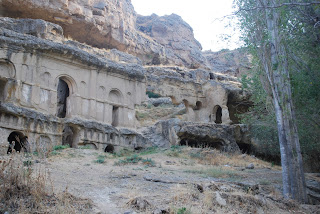Saturday, January 15, 2011
Kaya Kiliseleri, a deserted Armenian village
The hillside are pock marked with cave dwellings which are all empty and deserted. There is a haunting feeling in the air, this was probably a very prosperous place at one time but a pogrom drove out the residents. It felt like the ghosts are still roaming these hills seeking justice. Unlike other places in Cappadocia where modern residents move in to take over what is left, here, there is no one. Just some lonely sheep herders have anything to do with this place.
This was probably the residence of a wealthy Armenian. It's a huge complex.
Images like this can change a person's life, it did mine. I came back and devoured a few books on the Armenian genocide. Genocide means the systematic destruction of a peoples presence and culture. The Armenian genocide was the first of such in modern history. The kingdom of Armenia happened to be around the South Eastern part of Asia Minor and the Armenians converted to Christianity 3000 years ago. At the time leading to the genocide there were American missionaries in that area trying to convert the Turkish people but they found a more willing audience in the Armenians. Some Armenians live in the Turkish side, others live in the Russian side. When Turkey and Russia went to war, the Turkish army were suspicious of the Armenians and the Ottoman Sultan wanted to put an end to their Armenian problem once and for all. So the massacre and deportation of Turkish Armenians started in the last few years of the Ottoman rule but continued and with increased fervor under the new revolutionary guards under the new name, 'the Young Turks.' It did not matter that the Turkish Armenians pledged their allegiance to Sublime Porte (office of the Turkish government). The atrocities have been well documented, not just by Armenians themselves but also by other foreigners including the Germans, Germany and Turkey were collaborators during the first world war which was the same time the fiercest slaughter of Armenians were occurring.
My Armenian friends are so grateful when they hear that I am even interested in their history, so interested that I want to write about it.
Subscribe to:
Post Comments (Atom)






























1 comment:
Dear ANNECHUNG,
Thank you so much for the pictures and the words you posted.
Ara Ashjian,
Yerevan, Armenia
http://ara-ashjian.blogspot.com/
Post a Comment